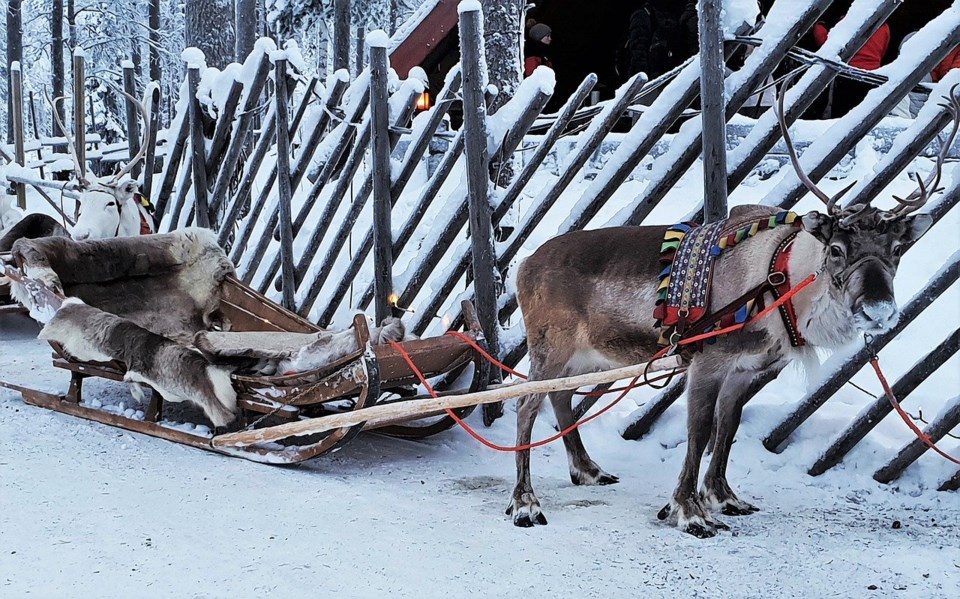NORTH POLE — Being responsible for the reindeer that pulls Santa’s sleigh is no easy task, but a rewarding one according to Lyle Smee.
Reindeer, otherwise known as caribou, can be found in the wild in northern Europe, Siberia and North America.
Smee has been responsible for the care and upkeep of Santa’s own North Pole reindeer for the last 25 years.
To take the role it required four years of training from the previous reindeer handler.
The job requires checking on the animals throughout the day, but leaves the rest of the day open for Smee to do what they want.
“When I’m not busy with work, I’m mostly spending time with my own children. We have a game here they really like called ‘snowball hockey’. It’s like hockey, but with added protection and the viewers can throw snowballs at the players,” Smee said before laughing. “The snowballs are carefully inspected beforehand to not have any ice in them. The rink does require almost constant cleaning though.”
Smee proceeded to excitedly discuss the sport regulations and their own snowball hockey trophies before getting back on topic to talk about the reindeer.
They said what shocked them most when first meeting the animals was the size.
“They’re not very big. That’s what I was shocked at. I was thinking big like deer or elk, that it was going to be at least past my head but they’re not very big at all,” Smee said.
“When I was little I thought Santa’s reindeer are as big as a horse. They’re smaller.”
The height of an average reindeer is four to five feet from hoof to shoulder, which is below the average height of a fully grown human – and in Smee’s case, at just five feet, shorter than them.
In addition, the animals are bulky.
“They’re not super fined boned, they’re kind of clunky. They’re not like a deer where they have these nice thin little legs, and these tiny little feet. They’re quite thick. They have shorter stalky legs, and quite a large hoof. The antlers were quite nice.”
The hooves contain a scooped out shape, which is key for digging through the snow in search of food when wild. The bulkiness serves as a useful tool for paddling through water.
Another thing that surprised Smee was how quiet they were.
“A lot of the reindeer we use for Santa are actually halter-broke, so they wear little halters and they can be led – they’re not very flight-y. Excuse the pun.”
An adult caribou can eat 12 pounds of food each day.
“They have four stomachs, so they’re just like a deer. They’re herbivores, so vegetation,” Smee said. “They will eat grains like oats, or barley, grasses, anything like that.”
Unlike traditional reindeer, Smee said Santa’s unique reindeer have subtle mutations to their digestive system allowing them to eat candy and other food not typically healthy for an ordinary caribou.
“When my children were younger they used to come out to the fields outside the barn and sprinkle oatmeal with sparkles so that the reindeer had a snack to eat.”
They said either are good choices for children who want to leave treats for the animals come Christmas Eve.
The classic and most well-known reindeer that have pulled Santa were first recorded in 1823, with the poem "A Visit from St. Nicholas.” Their names were Dasher, Dancer, Prancer, Vixen, Comet, Cupid, Dunder, and Blixem. Dunder later became known as Donner, while Blixem was later changed to Blitzen.
A different reindeer would later became known around the world when, in 1939, the story of Rudolph was first published. “Rudolph the Red-Nosed Reindeer” told the story about a reindeer with a unique physical trait of having a shiny red nose.
Smee refused to confirm if it’s still the same reindeer that pull Santa’s sleigh today – almost 200 years later.
“It’s their legacy that counts,” Smee said. “Whether it’s the same reindeer, or their great-great-great grandchildren, it’s about the joy they bring – the magic.”
Special thanks to Kim Hoshizaki, owner and veterinarian at the Animal Health Clinic of Humboldt, for connecting the Humboldt Journal to Smee*.
*Editor's note: Lyle Smee is a fictional character. The reindeer facts are real.



